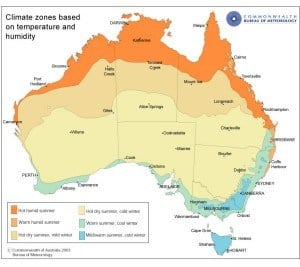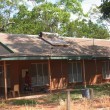B8.1 Human comfort and climate
Heat
All people constantly produce heat. To remain comfortable in a warm or hot climate, the body tries to lose heat at the same rate, or even a higher rate, than it is produced. The body’s natural way of losing heat is to sweat because the process of evaporating the sweat from the skin removes heat from the body. Australian research shows that, on average, the body can maintain comfort until the temperature is 29.5ºC. In higher temperatures, people usually start to feel uncomfortable.
In a humid climate, the rate of evaporation is lower because there is a higher amount of moisture already in the air. When relative humidity exceeds 60%, the body has more difficulty cooling itself with sweat. However if air from a breeze, draught, or fan moves across the body, the evaporation rate will increase, which is why fans can be effective in tropical climates. It has been estimated that a breeze of 0.5 metres per second can provide a comfort benefit as high as a 3°C temperature reduction.
Our bodies can also lose heat by exposure to cooler air or through cool surfaces that cause the body to radiate heat to these surfaces. This is why lying on a cold floor or getting into cold water can cool the body down. The greater the difference in temperature between our bodies and the cool surface, the more body temperature we will lose.
Cold
In cold climates the body needs to make up for lost heat. The body’s natural defence against the cold is to shiver, which increases the internal heat produced; moving or exercising will also achieve this result. Putting on more clothes helps to insulate the body against losing heat to the cold air, as does moving away from cold winds. Australian research suggests that, if properly dressed, the body can maintain comfort at temperatures of around 15ºC. Below this temperature, most people begin to feel uncomfortable.
Our bodies can gain heat that is radiated from a warm surface, such as a heater. This is why artificial heating is useful in colder climates especially where temperatures fall below 15ºC.
In Australia
There is substantial variation in climatic conditions across Australia, as shown in the map below. When designing new houses, or major housing upgrades, it is essential to know the local climatic conditions and understand the passive design strategies that apply to those conditions. The characteristics of the six climatic zones in Australia and design strategies are also summarised below.
Climate zones based on temperature and humidity
Source: Australian Government Bureau of Meteorology, 2016
The transitions between these zones are gradual and there can be substantial variation within a region, even over relatively short distances. For example, Cairns rarely experiences minimum temperatures of less than 15°C, towns and communities on the tablelands only 40 kilometres from Cairns may experience nights when the temperature falls below 0°C.
The Australian Bureau of Meteorology web site often has data about local or regional climatic conditions and community members are a useful source of information about local weather conditions. Consider also that local people will be, to some extent, acclimatised to the prevailing conditions in their community and may have different perceptions of hot and cold comfort levels.
Design and Specification
Consider
‘Tropical’―hot humid summer and warm winter
Overview of climate
- high temperatures all year, and seasonal change distinguished more by change in humidity and rainfall than temperature
- little change between day and night temperatures, meaning little cooling effect on building fabric
- hot, wet summer with average maximum summer temperature and humidity level exceeding human comfort levels
- warm, dry winter with average mean winter temperature within range of human comfort.use lightweight (low mass) construction
- maximise cross-ventilation
- locate the house for exposure to breezes and shading all year.
Design strategies
- use lightweight (low mass) construction
- maximise cross-ventilation
- locate the house for exposure to breezes and shading all year.
‘Sub-tropical’―warm humid summer and mild winter
Overview of climate
- warm temperatures all year with only two seasons, distinguished by change in temperature and rainfall
- moderate to low change between day and night temperatures
- warm, wet summer with the average maximum temperature within the upper limit of the human comfort range, but a significant number of days exceeding these temperatures
- average summer humidity exceeds human comfort levels
- mild, dry winter with average mean temperature within range of human comfort, but falling below the range at nights and on a number of days.use lightweight (low mass) construction where change between night and day temperatures is low, consider using some, protected thermal mass where there is a greater day to night temperature (diurnal) change
- maximise cross-ventilation, but provide shelter from cold winter winds
- site for exposure to breezes and shading in summer months
- position living areas to capture the northern sun in winter.
Design strategies
- use lightweight (low mass) construction where change between night and day temperatures is low, consider using some, protected thermal mass where there is a greater day to night temperature (diurnal) change
- maximise cross-ventilation, but provide shelter from cold winter winds
- site for exposure to breezes and shading in summer months
- position living areas to capture the northern sun in winter.
‘Arid tropical’―hot, dry summer and warm winter
Overview of climate
- significant change between day and night temperatures
- hot to very hot summers and average maximum temperature regularly exceeding human comfort levels but humidity within human comfort levels
- warm, very dry winters with average mean temperature within the range of human comfort but falling below the range at nights.
Design strategies
- use passive solar design with insulated thermal mass that is well shaded in summer
- maximise cross ventilation, but provide shelter from cool winter winds
- site for exposure to breezes and shading in summer months
- position living areas to get northern sun in winter.
‘Hot arid’―hot, dry zone and cold winter
Overview of climate
- low rainfall all year, at least two and often four distinct seasons distinguished by temperature
- high variation between day and night temperatures
- very hot summers with hot, dry winds, average maximum temperature exceeding human comfort levels, and average humidity within human comfort levels
- cold, dry winters with cold winds and average mean temperature below the range of human comfort, particularly at nights.
Design strategies
- use passive solar design with insulated thermal mass that is fully shaded in summer
- use convective cooling (venting of high level hot air to draw in cooler air from lower levels) to maximise night time cooling in summer
- provide protection from prevailing winds in summer and winter
- position the living areas and glazing to capture the northern sun in winter.
‘Temperate’―warm summer and cool winter
Overview of climate
- four distinct seasons, with middle seasons of spring and autumn being ideal for human comfort range
- moderate variation between day and night temperatures (higher for inland locations)
- warm to hot, dry summers with average maximum temperatures within the human comfort range, but some days that exceed this temperature
- summer humidity within human comfort range
- cool to cold, wet winters with average mean temperature below the range of human comfort.
Design strategies
- use passive solar design with insulated thermal mass that is well shaded in summer
- use cross ventilation, passive cooling and convective cooling in summer
- provide protection from prevailing winds in summer and winter
- position the living areas and glazing to capture the northern sun in winter.
‘Cool temperate zone’―mild to warm summer and cold winter
Overview of climate
- four distinct seasons, with middle seasons of spring and autumn being within human comfort range
- high variation between day and night temperatures
- warm to hot, dry summers with average maximum temperatures and humidity within human comfort range
- cold to very cold, wet winters with average mean temperature below the range of human comfort.
Key design strategies
- use passive solar design with insulated thermal mass that is well shaded in summer
- use cross ventilation and passive cooling in summer
- extensive north facing rooms and glazing for sun in winter
- consider double glazing.
Real world examples of Solutions
Standard And References
Australian Government Bureau of Meteorology website http://www.bom.gov.au
Reardon, C. and Marker, A. 2002, Your Home Guide, Design for Climate Section, Institute for Sustainable Futures, University of Technology, Sydney


